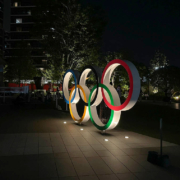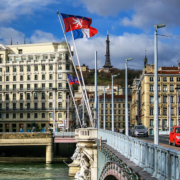In 2025, the Tour de France will once again end the way millions of spectators around the world are used to seeing it – with a grand finish on the Champs-Élysées. In 2024, this was impossible: Paris was actively preparing for the Olympic Games, and the final stage of the cycling race was moved to Nice for the first time in decades.
» READ MORE – Audio Guide to Paris: Listen, Walk and Fall in Love with TouringBee
Return to the Champs-Élysées in 2025
In 2025, the Tour de France will live up to its title of «The Great Loop,» with four countries on the route: Italy, France, San Marino, and Monaco. The race will begin with stages abroad, but the main part will, as always, take place in France – along its scenic and challenging roads.
On French territory, the route will pass through seven regions. The organisers purposefully rotate the regions: every 5-6 years, they try to cover the entire map of the country so that no region is left out. In 2025, special attention will be given to the north – regions that missed the race during the Olympic year of 2024 will return to the programme.
Montpellier and Marseille, which were sidelined last year due to Olympic preparations, will once again welcome the Tour de France in 2025. Orléans, by contrast, will be left off the route this time in favour of regional rotation.
The final stage will return to its classic format: the Champs-Élysées will once again set the stage for the race’s grand finale, just as it did for decades before the Olympic pause.
Tour de France 2025 in numbers
The 2025 Tour de France will feature the traditional 21 stages: seven mountain stages, five mid-mountain, and eight flat stages, along with one team time trial and one individual time trial. As always, there will be two rest days.
The final stage will once again be a classic sprint along the Champs-Élysées, unlike the individual time trial that concluded the race in 2024.
- Total route length: approximately 3,450 kilometres
- Vertical altitude gain: over 50,000 metres
- The highest point of the 2025 Tour: Col du Galibier Pass in the Alps (2,642 metres), famous among cycling fans for its legendary climbs
New cities and regions
New participants have joined the route this year:
- Cities in northern France, including Lille and Rouen, return after a pause
- Monaco and San Marino become international highlights of the race
- Southern regions such as Marseille and Montpellier are included again after the Olympic break
In total, the Tour de France 2025 will pass through 40 cities, 10 of which are hosting the race for the first time.
A full route map, stage breakdowns, and profiles are available on the official Tour de France website.
Tour de France 2025 cycling race route
The Tour de France route changes each year but always retains its essence – challenging stages, picturesque settings, and France’s deep historical ties with its neighbours. In 2025, all of this will be presented with a fresh perspective.
The start in Turin
In 2025, the Tour de France will once again begin outside France – this time in the Piedmont region of Italy. The first stage will start in Turin. Italy continues to play a significant role in the route: the first two stages will take place on Italian soil, honouring the close ties between the two countries in cycling history.
Unlike 2024, when the race began in Florence and ventured into San Marino for the first time ever, the 2025 edition will follow a more classic spirit with modern touches. The organisers will pay tribute to Italian cycling legends such as Fausto Coppi and Marco Pantani.
Although the start line has moved north, Italy’s participation in the Tour de France remains a matter of prestige – and a true celebration for fans.
The most spectacular stages of the Tour de France 2025
The 2025 route promises to captivate audiences not just with its competitive edge, but also with breathtaking views. Several stages have been designed to be watched in slow motion – moments where the landscape rivals the race itself.
Stage 9: Gravel, vineyards and an endurance test
The hilly roads of the Champagne region between Reims and Chalon will challenge the riders with 190 kilometres of winding terrain, narrow asphalt ribbons through vineyards, and notorious gravel sections. This isn’t just a stage – it’s a full test of technique, nerves, and character. On this day, the off-road segments become part of the spectacle.
Stage 12: Pace, attacks and an even battle
Covering 215 kilometres from Annecy to Grenoble, this stage runs through the beautiful valleys of Savoie. Here, speed and tactics take centre stage rather than elevation. With no extreme climbs, it’s ideal for breakaway groups and potential sprint surprises. This is a balanced race – both in terms of elevation and opportunity.
Stage 19: An alpine meat grinder for the yellow jersey contenders
The mountain climax of the Tour de France will force riders to conquer three passes above 2,000 metres, including the iconic Col d’Izoard (2,360 m) and Col du Galibier (2,642 m). Fans have already dubbed this section the «meat grinder» – a brutal stretch where the outcome of the general classification is often sealed. The Écrins National Park will serve as the dramatic backdrop to a battle of endurance and gravity.
Final stage: The return of the classics to the Champs-Élysées
The 21st and final stage, about 115 kilometres long, will take riders through the scenic outskirts of Paris before entering the familiar Champs-Élysées circuit. Spectators can expect a dramatic sprint for the green jersey – a thrilling conclusion even for casual viewers.
Join the fans along any part of the route. Your support matters to the athletes – and you’ll get a unique chance to see diverse French regions while admiring the competitors’ incredible stamina.
The jersey is more than just a uniform
Each jersey is a symbol of excellence in a specific category – a way to recognise the heroes of the Tour even before the final rankings. Here’s what the riders are competing for, and why colours carry meaning.
| Color | Title | What it’s for |
| Yellow | Maillot Jaune | It is the main trophy of the Tour de France and the symbol of the champion. Different riders can win stages, but the yellow jersey is for the most consistent and strongest rider. |
| Green | Maillot Vert | A reward for riders who win on flat finishes and collect points on intermediate sprints |
| White with red polka dots | Maillot à Pois Rouges | Awarded to the rider with the most points for summiting mountain passes |
| White | Maillot Blanc | Same logic as the yellow one, but only for riders under 25 years old |
If you’re a cycling holiday enthusiast, consider taking a cycling tour of France. This type of travel has recently gained immense popularity among tourists. The variety is incredible – untouched landscapes, shifting cultures, Roman bridges, medieval castles…
» READ MORE – Bike trip around Provence
For beginners, we recommend routes in and around Paris and its suburbs. Biking through the Loire Valley’s châteaux is also a gentle introduction. For intermediate riders, the French Riviera and the banks of the Rhône offer scenic challenges. Experienced cyclists may venture into Brittany or tackle the lavender-scented climbs of Provence.
Enjoy your journey!



 Mingrui He / unsplash.com
Mingrui He / unsplash.com 
 Ståle Grut / Unsplash
Ståle Grut / Unsplash  Shinnosuke Ando / unsplash.com
Shinnosuke Ando / unsplash.com 
 MOON / Unsplash
MOON / Unsplash  Willian Justen de Vasconcellos / Unsplash
Willian Justen de Vasconcellos / Unsplash Udo / Pixabay
Udo / Pixabay
Leave a Reply
Want to join the discussion?Feel free to contribute!